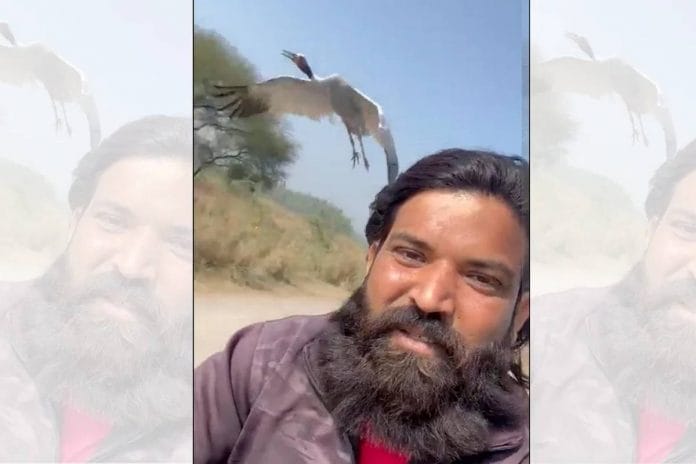A few days ago, I saw a viral BBC video about an Uttar Pradesh farmer, Mohammed Arif, who had nursed an injured sarus crane back to health in February 2022, after which the bird simply refused to leave his side. The sarus was not kept captive, but because Arif continued interacting with and feeding the bird even after its recovery, it kept returning to him. It clearly didn’t perceive him as a threat. If anything, Arif became an easy source of food for it. The video had clips of Arif feeding this fully-grown crane straight out of his hand and sharing cooked food from his plate. Most people cannot fathom why this is wrong. But I don’t blame them because, just like Arif, they are unaware and don’t know better. This video glorifies the ‘bond of friendship’ between a man and a wild bird — a relationship that should never have existed in the first place.
On 9 March 2023, Arif was booked under the Wildlife Protection Act – a provision of which safeguards the sarus and prohibits people from keeping or feeding the bird. Since then, there’s been much debate about how this went down, the reasons behind it, and whether or not it was right to seize the bird.
Here’s a question: Was it easy to locate and capture the free-flying sarus crane when the department came to seize it? Probably yes. Its behaviour patterns were known, and it was well-accustomed to being around a person who could easily feed it by hand. This sarus crane – the tallest flying bird species in the world – is more vulnerable because of the ease of luring and capturing it. The truth is, any miscreant could have caught it, as the stage to do so was set – not just by Arif’s past interventions but also by all the information being put out in the media.
Also read: Bound, choked and tortured—Diwali isn’t bright for Indian owls
The vulnerability of the sarus
The sarus crane (grus antigone) is a large non-migratory bird found in parts of the Indian subcontinent, Southeast Asia, and Australia. At 5 feet 11 inches, its height can match a tall human being’s, and it looks extremely elegant with its bright red slender neck contrasting against its grey body. The sarus crane is UP’s state bird, found in good numbers in Etawah and Auraiya. It is known to thrive in wetlands, and forage on roots, tubers, insects, crustaceans, and other small vertebrate prey.
The sarus crane is now included in Schedule 1 of the Wildlife (Protection) Amendment Act 2022, which will come into force on 1 April 2023. The bird is listed as “vulnerable” in the International Union for Conservation of Nature (IUCN) Red List of Threatened Species. The biggest threats to its existence are habitat loss and degradation due to the draining of wetlands and the conversion of land for agriculture. While the birds are known to adapt and live in agrarian landscapes, it is far from safe for them there. Foraging in fields exposes them to pesticides, poisoning, electrocution, and other threats associated with developing landscapes.
While human bonding with the bird seems enamouring for many, is it admirable? Sarus cranes are monogamous and bond with their mates for life. They are known to pine the loss of their mates, even to the point of starvation. While Arif was definitely well-intentioned in helping an injured bird, he is just a farmer and not an experienced rehabilitator — what you really see in the video is a classic case of rehabilitation failure. The aim of wildlife rehabilitation is to ensure the animal stays wild and independent when re-introduced into its natural habitat. Its future survival entirely depends on keeping its distance from humans. A farmer might not be familiar with wildlife rehabilitation protocols. And Arif’s inability to appropriately rehabilitate the sarus crane shows that. It was the media that glorified this story of misguided compassion — resulting in the man getting booked and the bird getting captured.
Also read: Roofed turtles, iguanas, ball pythons as pets is bringing Indians false sense of glamour
Involving wildlife authorities is key
While helping an animal in distress can be justified, the message that has gone out post Arif’s arrest and the bird’s seizure is that there can be no good outcome for you or the animal if you end up overstepping your bounds. If you rescue a wild animal, report it to the authorities. If you are not authorised to rehabilitate wildlife, you shouldn’t because, in the eyes of the law (as in Arif’s case), you are enticing, luring or ‘baiting’ the animal. There is a fine line between right and wrong; only the law can determine the appropriate action in such cases. If the forest department had not registered the offence, naysayers would have held it responsible for taking no action.
Should the bird have been left there and weaned off human interaction and feeding? Maybe, but controlling these situations on the ground is far more challenging than most can imagine. The BBC story caused enough damage by romanticising the equation between Arif and the sarus.
Generally speaking, once seized, an animal undergoes medical checks and a period of observation before it can be deemed fit for reintroduction into the wild. The bird is currently quarantined in Kanpur Zoo. As for blame games, the only ones to be blamed here are those who have glorified this story. Not the forest department, not the man, and not the bird.
Neha Panchamiya is Founder and President, RESQ Charitable Trust. She tweets @neha_panchamiya. Views are personal.
(Edited by Zoya Bhatti)






